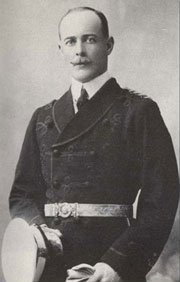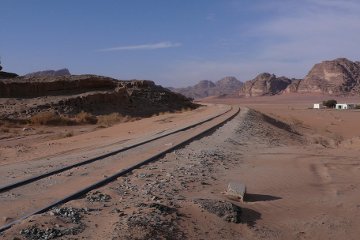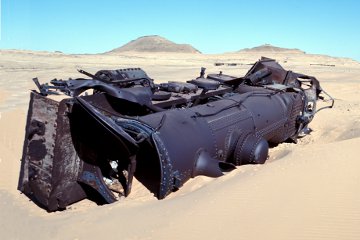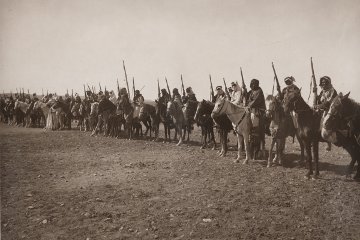The Explosive Archaeologist
At the start of the First World War Sayyid Hussein bin Ali was the Sherif and Emir of Mecca, appointed to that position by the Ottoman government because of his descent from the house of Hashem and therefore from the prophet Mohammed himself. Despite this, he had no great love for the Turks and when he discovered that the Turks were planning to depose him, he began to look around for allies. The obvious candidates were the all-powerful British.

| |
| Captain William Henry Shakespear, the English explorer and adventurer. |
At this time the British Foreign Office was being bombarded with demands from its Political Agent in Kuwait, a certain Captain William Henry Shakespear, that Britain should recognise an upstart sheikh in the east of Arabia, a man called ibn Saud. When war broke out, Shakespear was instructed to work among the tribes and bring them over to the British side - and naturally he went straight to ibn Saud. How matters might have proceeded we shall never know, because Shakespear got himself killed!
It was one of those minor skirmishes that did so much to make life in the Arabian Peninsula interesting in the days before satellite TV. Ibn Saud and his tribesmen were out against the pro-Turkish ibn Rashid of Hail and the Shammar tribe. On January 24, 1915, both sides duly lined up, camel riders to the fore, foot soldiers lagging behind and His Majesty's representative loyally sticking by the side of his host.
It was a typical Arab affair. One side advanced, chanting its war song and firing its guns in the air until all its ammunition was used up and then the other side advanced doing much the same thing until it too had used up its ammunition. Meanwhile the other side had refilled its ammunition pouches from the supply camels in the rear and was ready to make another advance, and so the long day wore on. It was all well-understood and everyone had a great time.
It so happened that ibn Saud's forces were the first to advance and when it was their turn to retreat, the British representative stood his ground, firing his pistol and shouting, "Come on, you chaps! Steady the Buffs! Thin red line and all that!"
The other side didn't know what to make of this red-faced lunatic all on his own and defying all the rules of Arabian warfare, but when he started to take potshots at them with his revolver they were more or less forced to shoot him in self-defence. He was, if I remember rightly, the only casualty of the day-long battle.

| |
| Colonel T. E. Lawrence, better known as "Lawrence of Arabia". |
Not everyone in the Arab Bureau of the Foreign Office had agreed with Shakespear and with his death opinion swung more heavily in favour of Sayyid Hussein, whose position as Sherif of Mecca made him appear much more likely to succeed than the defacto and uncertain ruler of Riyadh. In a fateful moment, the Cairo office decided to send a little known intelligence officer from Cairo, a man who spoke Arabic and had been working among Arabs as an archaeologist to carry a message to Hussein. The officer's name was Thomas Edward Lawrence.
Somewhat to British consternation, Hussein had not waited for their permission; he had already started what became the Arab Revolt. In his first attacks he succeeded in expelling the Turks from Mecca and a few other places, but then the campaign stalled. His three sons were in command of groups of tribesmen, attacking the Turks in various places, but they were desperately short of modern weapons and under constant threat from the Turkish garrison in Medina, which was preparing to recapture Mecca. Aided by the British navy and the Arab Office in Cairo, Lawrence was able to help the Arabs confine the Turks to Medina and then prepare to capture the place.
However as Lawrence travelled from the British base at Wejh to another meeting with Prince Feisal, he fell sick and during his illness and convalesence he suddenly realised that rather than capture Medina, it would be much better not to capture Medina!
So long as the Turks held Medina, they would feel obliged to support their soldiers there, and the only way they could do that was by sending supplies and fresh troops along the Hijaz Railway. By mounting pin-prick attacks against the railway, the Arabs could force the Turks to devote more and more resources to protecting the railway - resources that could not then be used elsewhere in the war.

| |
| The Hijaz Railway as it is today near Wadi Rumm. |
Built in 1900 by the Turks, with German advice and engineering skills, the Hijaz Railway started in Damascus and was intended to reach all the way to Mecca. The proclaimed purpose of the railway was to facilitate the travel of pilgrims undertaking the Haj, the pilgrimage to Mecca that is a duty for all Muslims. To emphasise this aspect of the railway the government set up a Waqf or religious trust which would own and operate the land, railroad and rolling stock.
However the underlying purpose of the railway was to help the Ottoman government keep control of the often turbulent tribesmen of the Arab world. The sultan was, after all, the Caliph, the supreme ruler of the Faithful, a claim which could only be maintained if he controlled Mecca. The railway was intended to reduce the time taken for reinforcements to reach Mecca from Istanbul down to 120 hours - a considerable improvement over the months that it would take on horse and camel-back.
To finance the railway, the Turks invoked the bogey of the big, bad infidel and let it be known that the railway was intended to protect the Hijaz against the British. Although the British had no desire to take over the wastes of Arabia - oil had not been discovered yet - the threat was plausible because they were firmly ensconced in Egypt, which was just across the Red Sea. The result was that thousands of donations came in from all over the world and the railway - unusually for such an ambitious project - was opened free of debt.
Right from the start the beduin had attacked the railway, both as part of their immemorial habit of preying upon travellers and because Hussein saw it as a threat to his own position in Mecca - which it undoubtedly was. However, quite apart from deliberate attacks, the beduin also saw no harm in removing sleepers as fuel for their cooking fires; as a result iron sleepers were gradually laid as replacements.

| |
| One of the engines destroyed by Lawrence lies where it fell in the Arabian desert. |
Lawrence decided to adapt and improve this beduin raiding and turn it into a powerful weapon against the Turks. He developed the technique of planting mines beneath the railway line, connected by wires to a primitive control box 200 yards away. As the engine of a slow-moving train passed over the mine he would push down hard on the handle of the control box, thus generating a pulse of electricity that detonated the mine. In the confusion and shock that followed the explosion, his Arab companions would swarm out from their hiding places and attack the train, looting it and everyone on it.
The Arabs were delighted with the booty they acquired, Lawrence was delighted with the destruction he was causing. Each engine destroyed meant that a new engine had to be acquired from Germany. Each train looted meant that the Arabs became that much better off and the Turks that much worse off. Each attack meant that more and more Turkish soldiers were devoted to patrolling and guarding the railway line.
Before he could start to attack the railway, however, he needed mines and machine guns and all the paraphenalia of war - and before the British government would supply that, he had to prove that the Arabs were a serious fighting force. The earlier death of the British representative had not gone down well with His Britannic Majesty's government! Lawrence's first attack, therefore, had to be a dramatic one.
Lawrence mobilsed a force of Arabs under the command of a famous fighting sheikh, Auda Abu Tayi, and then disappeared with them into the desert. The regular army required roads and logistic services, but Lawrence realised that the beduin, who were used to wandering in the desert, could - like the British navy - appear out of nowhere and attack at will.
Seven weeks later, Lawrence and his men appeared out of the desert and poured down the wadi towards Aqaba, the last remaining Turkish port on the Red Sea. At the head of the steep and rugged wadi there was a spring known as Aba el-Lissan and a blockhouse at Fuweilah and Lawrence sent a party of tribesmen to attack it. This they did, but failed to capture it and half the garrison set out to a nearby tribal encampment and cut the throats of the half dozen women and children they found there.
Enraged by this, the tribesmen surged forward and captured Fuweilah, taking no prisoners. However news of the attack reached Ma'an and a newly arrived battalion was sent out to restore the situation. It retook the blockhouse and then, foolishly, set up camp in the valley beside the spring.

| |
| Lawrence's army of beduin warriors, a posed photograph for Lowell Thomas, who made a fortune ($1.5 million) out of photographing Lawrence's war. After the war, when Lawrence was ostensibly avoiding publicity, Thomas commented, "He has a genius for backing into the limelight". |
Lawrence and his entire force rode through the night and by dawn were positioned on the rugged, rocky cliffs around Aba el-Lissan, sniping down at the Turks. By midday even the Arabs were gasping with thirst, for it was so hot that when they rested their arms against a rock to take aim, their skin was seared away! In mid-afternoon Auda led the fifty horsemen of his tribe in a wild charge against the Turks and Lawrence and his four hundred camels charged from the opposite side.
Shooting from the swaying back of a camel is not easy and with his fifth shot Lawrence shot his own camel in the back of the head, killing it instantly. He sailed through the air and nearly killed himself by landing against a rock! When he came to, it was to find 300 Turks dead and the surviving 160 prisoners and the way to Aqaba open before him.
Aqaba had been strongly fortified by the Turks - against attack from the sea! None of their defences faced inland, so as Lawrence and his men rode down the horrid gorge of Wadi Itm, they passed post after post, abandoned because it faced the wrong way. The final guard post took one look at Lawrence's gathering host and tamely surrendered.
After a day for rest, Lawrence set off with a few companions and rode his camel across the Sinai to Suez - and was nearly stymied when bureaucratic officials refused to ferry him across the canal! Fortunately a helpful switchboard operator came to his help and once in Cairo found an incredulous welcome. A British warship loaded with supplies was despatched to Aqaba, partly to relieve the needs of his ragtag army and partly to confirm the truth of his incredible story.
Lawrence returned to Aqaba to learn that the Turks were planning to recapture the port. He sent out forces to ambush them at Wadi Musa, amid the ruins of Petra. While he waited for the Turkish attack to materialise he led a party to Mudowwara where he destroyed a train full of troops bound for Mecca. Then he dashed north to attack Ma'an station; there he destroyed and looted a train of supplies for Medina, which provided enough loot to keep his followers happy for months.
Distracted by these raids, the Turkish attack on Wadi Musa was completely defeated. Maulud was in charge and he opened his ranks to let the Turks advance right up to the sandstone cliffs, then attacked them from both sides simultaneously. The Turks retreated, with heavy losses, and Arabs came flocking in to join the revolt. Inspired and armed by Lawrence, tribesmen and villagers blew up seventeen trains between Ma'an and Damascus and severely reduced the ability of the Turks to supply both Medina and their armies in Palestine, which were now facing attack from General Allenby.
With Aqaba secure from attack, Lawrence moved to Wadi Rumm and made it his headquarters, though when winter came he went on to Azrak and settled into the old Arab castle there. When spring returned he moved north towards Amman and Damascus and boldly ventured into Dera'a to see for himself how the Turks were affected. While walking down the street he was seized by Turkish soldiers and marched into their headquarters.
To his surprise, however, it appeared that the Turks had no idea who he was and had merely been attracted by his white skin. Although Lawrence never revealed exactly what happened, many have concluded that he was raped by the Turkish commander and then allowed to go free, though he himself claims that he escaped the rape after being beaten so badly that the commander was disgusted by his battered body.
Nothing attracts an Arab like success, particularly when loot is involved, and this new and successful method of attacking trains brought the beduin - and many of the Syrian peasants - flocking to Lawrence's side. It also brought him increased supplies from the British army, including a detachment of mortars and several Rolls Royce armoured cars. With this increased strength Lawrence was able to capture the railway station at Jurf.

| |
| The desert castle of Azrak which Lawrence used as his winter headquarters. |
The Turkish response was a full-scale attack on the village of Tafileh and Lawrence fought his only full-scale battle to defeat them, using the classical manouevres taught in army training schools of the time. That was followed by a bizarre battle between Lawrence's horse and camel cavalry and the Turkish navy, as represented by a flotilla of boats on the Dead Sea. Lawrence's men stormed the naval base and then towed the captured boats out into deeper water and scuttled them.
Despite the claims made in Lawrence's Seven Pillars of Wisdom, it is highly unlikely that the Arabs on their own could have defeated the Turks, even with the supply of weapons and equipment from the British. However while Lawrence's raiders were disrupting things east of the Jordan, General Allenby and his conventional forces were fighting massive battles in Palestine, forcing the Turkish army out of its positions and capturing Gaza, Jaffa and Jerusalem in the process. The Arabs undoubtedly shortened the war, but Allenby would have succeeded without them, though it would have taken longer and cost more British lives.
The decisive battle took place at Megiddo and as the defeated Turks streamed northwards, Lawrence roused the peasants of the Hauran. This was not difficult, as the retreating Turks committed one atrocity after another and the peasantry were thirsting for revenge. Lawrence was responsible for destroying one Turkish army as it retreated towards Damascus and then, in the proudest moment of his life, led his men into Damascus and put it under Arab control a day or so before the British arrived.
Lawrence had promised the Arabs freedom, knowing all the while that the British government had no intention of keeping the promises it made through him. His hope was that the Arabs could achieve such a position by the end of the war that the government would be more or less obliged to give them freedom.

| |
| The famous photograph of the Emir Feisal at the Versailles Peace Conference. Lawrence is immediately to his left on the step behind him. |
It was not to be. The victorious Allies awarded themselves "Protectorates"; the French got Syria, which they had long coveted, the British got Palestine, Trans-Jordan and Mesopotamia. As a sop to Arab feelings, the sons of Emir Hussein were installed as kings of the divided empire. Feisal became king of Syria, was subsequently expelled by the French and was then given Iraq. Abdullah became king of Jordan and his line continues to the present.
Whether Lawrence and Hussein's dream of a pan-Arab state spanning the whole of the Middle East could ever have been accomplished, in view of the deep ethnic and cultural divisions between Syria, Arabia and Mesopotamia, will never be known. My view is that even without the interference of the Allies, such a state would have fallen apart sooner rather than later along boundaries not too different from those of the present nation states. The only likely difference is that the modern state of Jordan would have become part of either Syria or Arabia - or possibly split between them.
Lawrence never returned to archaeology, probably because his fame or notoriety in Arab lands would have made it impossible. It was equally impossible for him to retire to private life in Britain, though he ardently tried the experiment, even enlisting in the Air Force under an assumed name. His tragic death in a motorcycle accident in 1935 perhaps spared him the pain of seeing the rapid disintegration of the Arab world he had known as oil, communism and modernisation destroyed the age-old romantic life of the desert.
It is a fitting testimony to Lawrence's sense of chivalry and honour that he never received any profit from his famous account of the Arab Revolt, Seven Pillars of Wisdom. All the money it made at the time and since has gone into a trust fund for the RAF Benevolent Fund, though after his death the fund diversified and now also makes grants for archaeological, environmental and academic projects.
Captain William Henry Shakespear Further information about this interesting character can be found on his geneological website. My description of how he died is based on the book Arabia by Philby. Return
developed the technique It was two British regulars, Newcombe and Hornby, who first attacked the Hijaz railway in this way, but although they were entirely successful in their work, they failed to inspire the Arabs to imitate them. It was Lawrence's strength that he was able to lead the tribesmen and thus his own efforts were multiplied a thousand-fold. Return
Wadi Itm The line from Ma'an to Medina was never re-opened after World War I; an attempt to open it was abandoned with the start of the Six-day War in 1967. Instead a new track was built down the Wadi Itm, clinging precariously to a shelf blased out of the cliffs on the opposite side of the valley to the road. This was for the benefit of trains carrying phosphate, Jordan's only major export, which is loaded aboard ships in Aqaba.
This is possibly the most dramatic part of the entire journey, as the train creeps cautiously round the curves imposed by the geography of the wadi, for you never know when boulders may tumble down from the cliffs above and block the track. The view is awe-inspiring, with tortured rock soaring high above the track and the winding course of the wadi reminding the traveller of the terrible power of the water that comes rushing through here, plunging in an unstoppable torrent 2,500 feet down to sea level, after rare rain storms hit the desert beyond. Return
Mudowwara At present this is the last station in Jordan before the Saudi Arabian border. Unfortunately the Saudis do not appear to be interested in restoring the railway, so the station is derelict, the line torn up and the bridges washed away by winter floods.
It is ironic to recall that the roadside IUDs in Afghanistan and Iraq are a direct descendant of the "tulips" planted by Lawrence on the Hijaz Railway and that it was Western powers who taught the Arabs the techniques of terrorism. Fortunately for us, neither then nor now do the Muslims appear to have grasped the broad strategic use of this method which guided Lawrence in his campaign and made it an ultimate success. For them it is enough that they set off a loud bang and kill a few people, neither of which are going to win a war in the long term. Return
escaped the rape It seems certain that this experience damaged Lawrence psychologically and was, in large part, responsible for his later self-destructive behaviour. Return
Seven Pillars of Wisdom I first came across references to this book in a children's book about famous men, which gave a bowdlerised version of his adventures. In 1969 in Luxor, bored with ancient ruins and made fractious by the heat, my parents took us to a second-hand book shop and allowed us to choose one book each.
The shop seemed like heaven, for we were all voracious readers, and we approached the book shelves with fervour. Almost at once I spotted a dog-eared copy of Seven Pillars of Wisdom and, hardly daring to believe my luck, demanded it while my siblings settled for lighter works more suited to our ages. Over the next few days I devoured the book, only vaguely guessing at some of the more florid passages, and have read it several times since.
Unfortunate readers of this website, who lack the opportunity of visiting second-hand book shops in Luxor, can nevertheless share in Lawrence's deathless prose by visiting the Project Gutenberg site. Although the book is all there, complete and unabridged, you will never know the breathless pleasure of turning its pages while the flies buzz and the harsh gutterals of passing Arabs sound outside the shutters of your hotel room.
Ever since our first trip along Jordan's Desert Highway, when I realised that the embankments away to the left were the famous Hijaz Railway, I have wanted to travel along it, preferably in a steam train. Unfortunately the line has been closed for half a century or more, as all the guide books will inform you. Annoyingly, freight traffic, in the form of long lines of trucks carrying phosphate, Jordan's only major export, trundle up and down the line daily.
I was delighted, therefore, to encounter someone with connections in the Jordanian State Railways and through her to arrange for what may be a once-only trip along that line, using vintage rolling stock and pulled by a steam engine. Click here for details of that forthcoming trip. Return
© Kendall K. Down 2011





